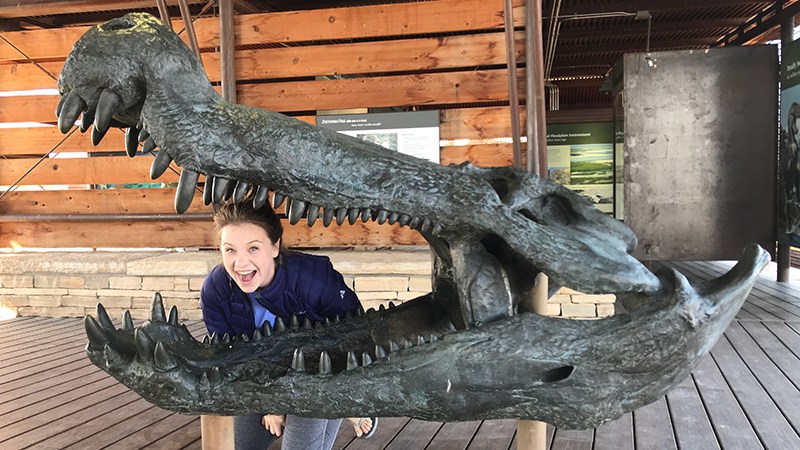
After hiking Boquillas Canyon, we stopped at the Fossil Discovery Exhibit on our way to the Persimmon Gap Visitor Center. This new exhibit, added in 2016, has a fossil-themed play area for kids, a short trail to a panoramic lookout over the surrounding desert, and replica dinosaur fossils and skeletons like life-sized bronze skulls of a Tyrannosaurus Rex and an ancient giant alligator.
At the Fossil Discovery Exhibit, you can experience the changes to Big Bend’s plants and animals, and the world they lived in, through 130 million years of geologic time.
The Fossil Discovery Exhibit is an open-air museum located between the Persimmon Gap Visitor Center and Panther Junction Visitor Center. At the fossil bone exhibit, you can learn more about the geology of Big Bend, see some of the park’s most amazing fossil finds, and view vivid artwork that tells the story of the region’s ancient life.
The story begins when a wide shallow sea covered Big Bend and much of Texas, leaving behind a fossil record that includes mosasaurs (swimming reptiles), predatory fish, sharks, and numerous sea shell fossils, like clams, oysters, snails, and sea urchins. As the ancient sea receded, Big Bend became a swampy, coastal environment, much like the coast of Texas today but inhabited by dinosaurs and giant alligators.
Later, the coastline moved east, and Big Bend was crossed by rivers and forests, where dinosaurs roamed and giant pterosaurs soared overhead. After the extinction of the dinosaurs, mammals flourished, including those whose bones were found just a stone’s throw from the Fossil Discovery Exhibit.
Big Bend national Park Fossil Facts
- The 130 million year fossil record preserved at Big Bend is one of a kind. Over 1200 fossil species have been discovered so far.
- Big Bend is the only unit in the NPS where the Cretaceous-Paleogene Boundary is exposed and can be seen. These rocks were laid down 66 million years ago during the extinction event that wiped out the dinosaurs and three-quarters of plant and animal species on Earth.
- The park contains marine and continental sedimentary rocks, intrusive and extrusive igneous rocks, and metamorphic rocks.
- The world’s largest known flying creature of all time was found in Big Bend NP. This is Quetzalcoatlus northropi, a pterosaur (flying reptile) with a 35-foot wingspan.
- Big Bend also has a tyrannosaur as big as the largest known Tyrannosaurus rex — probably a cousin of Tyrannosaurus rex and a new species — but not enough of it has been found to positively identify it by name.
- Another giant predator discovered is Deinosuchus riograndensis — a 35 foot long giant alligator that ate dinosaurs!
- At least 8 species of fossilized trees new to science were discovered in Big Bend National Park.











Know Before You Go
About the Fossil Discovery Exhibit:
- The Fossil Discovery Exhibit is located 8 miles north of the Panther Junction Visitor Center on the Persimmon Gap Entrance Road between the Persimmon Gap Visitor Center and Panther Junction. It is 57 miles south of Marathon, Texas, on US 385.
- The exhibit is open from dawn to dusk.
- A shaded picnic area is nearby, and it has an assortment of fossil-themed climbing structures for children.
- The exhibit is fully accessible by wheelchair and features tactile displays for the vision impaired. An accessible vault toilet is also available at the site.
About Big Bend National Park:
- Big Bend National Park is located in Brewster County, southwest Texas.
- The name Big Bend refers to the great U-turn the Rio Grande makes in Southwest Texas. The Rio Grande defines the park’s southern boundary for 118 miles.
- Park entrances are open 24 hours daily, all year and have variable seasons and hours.
- Admission fees are valid for seven days and are $30/vehicle, $25/motorcycle, $15/individual/bicyclist/pedestrian.
- There are five Visitor Centers in Big Bend National Park: Panther Junction, Chisos Basin, Castolon, Persimmon Gap, and Rio Grande Village.
- Download the Big Bend National Park maps.
- There are three developed campgrounds in the park: the Chisos Basin, Rio Grande Village, and Cottonwood campgrounds. Sites are first come, first-served, although a limited number of campsites in Rio Grande Village and the Chisos Basin campgrounds are reservable.
- Convenience stores are available and open year-round at Rio Grande Village, the Chisos Basin, and in the historic La Harmonia store at Castolon.
- Gas stations are located at Panther Junction and Rio Grande Village, and outside the park in Study Butte and Stillwell’s Ranch. Diesel is available at Panther Junction and in Study Butte.
- Pets are not allowed on trails, off roads, or on the river. Your pet can only go where your car can go and must be on a leash no longer than six feet in length or in a cage at all times. Pet etiquette and park regulations require that you always clean up after your pet and dispose of waste in trash receptacles.